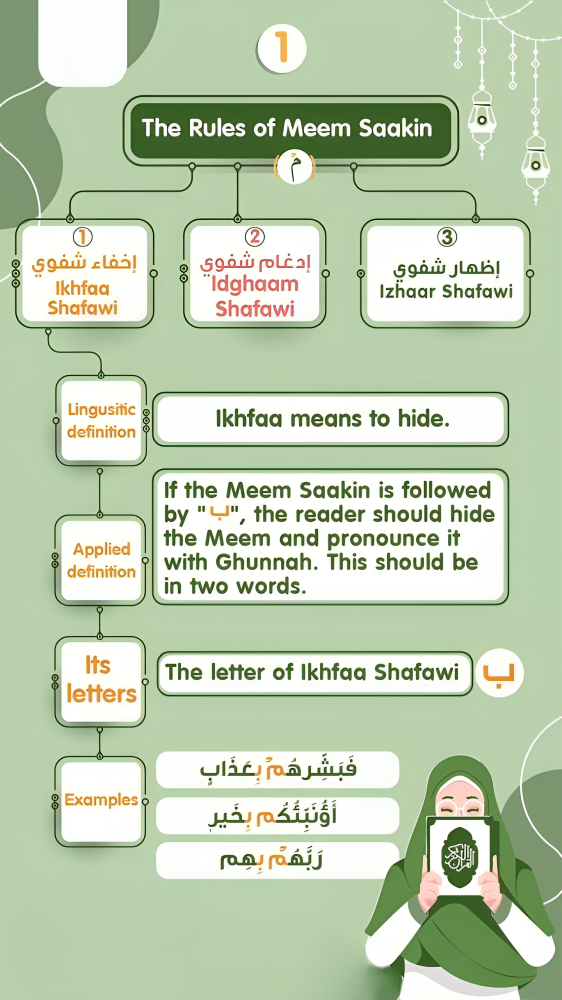Correct pronunciation of the Arabic letters is the cornerstone of Tajweed (rules of Quranic recitation). Among these letters, Raa (ر) holds a special place due to its unique makhraj (articulation point) and distinct characteristics. If not pronounced correctly, the sound of Raa can alter the meaning of Quranic verses, which is why mastering its articulation is essential. This blog will cover every detail about the Makhraj Al-Raa, its characteristics, mistakes to avoid, and practical tips to perfect its pronunciation.
Understanding the Makhraj of Raa (مخرج الراء)
The Makhraj (articulation point) of the letter Raa (ر) is:
- The tip of the tongue, which lightly touches the gums behind the upper front teeth.
When pronouncing Raa, the sound must pass smoothly through this area without unnecessary vibration or distortion. This articulation ensures that the letter retains its proper sound quality, contributing to the accuracy of Quranic recitation.
The letter Raa (ر) belongs to the group of letters that are pronounced from the tongue, specifically categorized under the articulation point known as Tarf al-Lisan (طرف اللسان)—the edge or tip of the tongue.
Characteristics (Sifaat) of Raa
The characteristics of Raa (known as Sifaat) are the qualities or attributes that define how the letter should sound. Raa has specific sifaat that make it distinct from other letters:
1. Tafkheem (تفخيم):
- Tafkheem refers to a bold, heavy sound, often described as “full-mouthed.”
- Raa is pronounced with tafkheem in the following cases:
- When it carries a Fatha (ـَ): e.g., رَبِّ الْعَالَمِينَ (Rabbil-‘Alameen).
- When it carries a Dhamma (ـُ): e.g., رُوحٌ (Ruh).
- When it is in a Sukoon (ـْ) state and preceded by a Fatha or Dhamma: e.g., قُرْآنٌ (Qur’aan).
2. Tarqeeq (ترقيق):
- Tarqeeq refers to a light, thin sound where the mouth remains neutral.
- Raa is pronounced with tarqeeq in the following cases:
- When it carries a Kasrah (ـِ): e.g., رِزْقًا (Rizqan).
- When it is in a Sukoon (ـْ) state and preceded by a Kasrah: e.g., فِرْعَوْنَ (Fir’awn).
3. Inhiraf (انحراف):
- This characteristic means the sound of Raa slightly bends or flows away toward the makhraj. It ensures that the Raa sounds smooth and continuous without harshness.
4. Tikrar (تكرار):
- The natural tendency of Raa is to produce a repetitive sound due to the tongue’s vibration. While tikrar is a natural attribute of Raa, excessive repetition must be avoided to maintain the clarity of the letter.
5. Istitaala (استطالة):
- Raa has a slight elongation, where the sound flows smoothly across the tongue, maintaining clarity and precision.
Types of Errors in Pronouncing Raa
The following mistakes are common when pronouncing Raa and should be avoided:
1. Excessive Tikrar (Over-vibration):
- Overemphasizing the natural vibration of Raa leads to a trilling sound, distorting its correct pronunciation.
2. Incorrect Makhraj:
- Placing the tongue too far forward or backward results in either unclear or completely incorrect articulation.
3. Mixing Tafkheem and Tarqeeq:
- Applying tafkheem where tarqeeq is needed, or vice versa, alters the sound quality and may change the meaning of Quranic words.
4. Flat Sound:
- Neglecting the slight bending or flowing of the sound (inhiraf) makes the Raa sound flat and unnatural.
Practical Tips to Perfect the Pronunciation of Raa
To achieve mastery over the articulation of Raa, follow these tips:
1. Practice Correct Tongue Placement:
- Ensure the tip of your tongue lightly touches the area just behind your upper front teeth.
- Use a mirror to observe and adjust your tongue placement.
2. Focus on Sifaat:
- Practice tafkheem and tarqeeq in different contexts to understand when each characteristic applies.
3. Listen to Experienced Quran Reciters:
- Pay attention to how expert reciters pronounce Raa, especially in varying situations of tafkheem and tarqeeq.
4. Avoid Over-vibrating the Tongue:
- Keep your tongue steady while pronouncing Raa. If you feel the tongue bouncing excessively, slow down and focus on maintaining control.
5. Recite Slowly and Deliberately:
- Break down Quranic verses containing Raa and pronounce them slowly to ensure clarity and precision.
Quranic Examples of Raa Pronunciation
Examples of Tafkheem:
- رَبِّ الْعَالَمِينَ (Rabbil ‘Alameen)
- قُرْآنٌ (Qur’aan)
- رُوحٌ (Ruh)
Examples of Tarqeeq:
- فِرْعَوْنَ (Fir’awn)
- رِزْقًا (Rizqan)
- بِرِّهِمْ (Birrihim)
The Importance of Makhraj Al-Raa in Tajweed
The letter Raa is one of the “Al-Huroof Al-Mustatila” (elongated letters), requiring specific care during recitation. Mispronouncing Raa can lead to significant changes in meaning. For instance:
- رَبِّ (Rabb) means Lord, while mispronouncing it could change its meaning entirely.
Mastering Raa not only enhances the beauty of your recitation but also ensures that you fulfill your responsibility of preserving the Quranic text as it was revealed.
Practical Exercises for Raa
1. Repetition Drills:
- Recite words with Raa in tafkheem and tarqeeq contexts repeatedly, such as:
- رَبِّ (Rabb)
- رِزْقًا (Rizqan)
- قُرْآنٌ (Qur’aan)
2. Record and Review:
- Record your recitation and compare it with experienced reciters to identify areas for improvement.
3. Learn with a Teacher:
- A qualified Quran teacher can provide real-time feedback and corrections, helping you perfect the makhraj of Raa.
Conclusion
Mastering Makhraj Al-Raa is a critical step toward proper Quranic recitation. Its unique articulation point and intricate characteristics demand focused effort and consistent practice. By understanding the makhraj, applying the rules of tafkheem and tarqeeq, and avoiding common mistakes, you can recite the Quran beautifully and accurately.
At Baytul Quran, we offer comprehensive online courses to help students worldwide perfect their Tajweed, including detailed lessons on the Makhraj of each letter. Enroll now at Baytul Quran to enhance your recitation and deepen your connection with the Quran.





